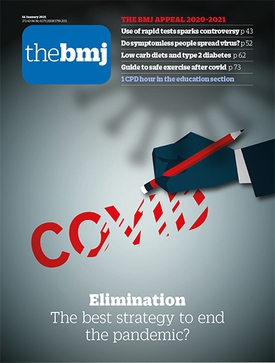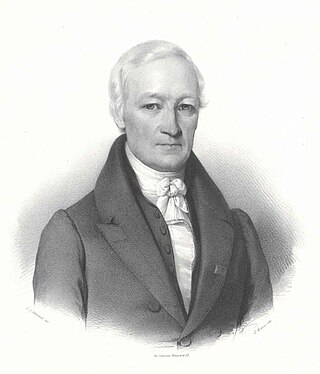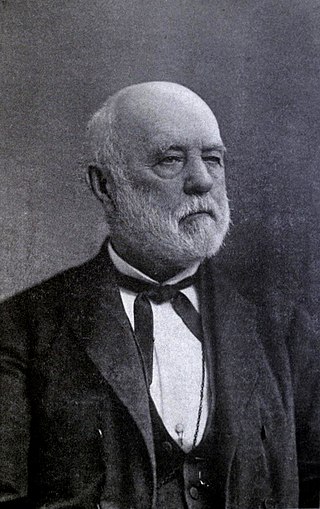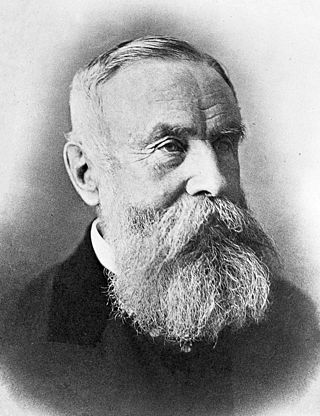
Phineas P. Gage (1823–1860) was an American railroad construction foreman remembered for his improbable[B1] survival of an accident in which a large iron rod was driven completely through his head, destroying much of his brain's left frontal lobe, and for that injury's reported effects on his personality and behavior over the remaining 12 years of his life—effects sufficiently profound that friends saw him as "no longer Gage".

The BMJ is a weekly peer-reviewed medical journal, published by BMJ Group, which in turn is wholly-owned by the British Medical Association (BMA). The BMJ has editorial freedom from the BMA. It is one of the world's oldest general medical journals. Previously called the British Medical Journal, the title was officially shortened to BMJ in 1988, and then changed to The BMJ in 2014. The journal is published by BMJ Publishing Group Ltd, a subsidiary of the British Medical Association (BMA). The current editor-in-chief of The BMJ is Kamran Abbasi, who was appointed in January 2022.

Richard Harlan was an American paleontologist, anatomist, and physician. He was the first American to devote significant time and attention to vertebrate paleontology and was one of the most important contributors to the field in the early nineteenth century. His work was noted for its focus on objective descriptions, taxonomy and nomenclature. He was the first American to routinely apply binomial Linnaean names to vertebrate and invertebrate fossils. Prior to the time of Harlan, it was common practice to publish only a genus name for a fossil animal that was new to science.

Mallory–Weiss syndrome or gastro-esophageal laceration syndrome refers to bleeding from a laceration in the mucosa at the junction of the stomach and esophagus. This is usually caused by severe vomiting because of alcoholism or bulimia, but can be caused by any condition which causes violent vomiting and retching such as food poisoning. The syndrome presents with hematemesis. The laceration is sometimes referred to as a Mallory–Weiss tear.

Friedrich Tiedemann FRS HFRSE was a German anatomist and physiologist. He was an expert on the anatomy of the brain.

Samuel George Morton was an American physician, natural scientist, and writer. As one of the early figures of scientific racism, he argued against monogenism, the single creation story of the Bible, instead supporting polygenism, a theory of multiple racial creations.

Morton Henry Prince was an American physician who specialized in neurology and abnormal psychology, and was a leading force in establishing psychology as a clinical and academic discipline.

William Samuel Waithman Ruschenberger was a surgeon for the United States Navy, a naturalist, and a writer.

Yehuda Shoenfeld is an Israeli physician and autoimmunity researcher.
Soma Weiss was a Hungarian-born American physician.

Henry Jacob Bigelow was an American surgeon and Professor of Surgery at Harvard University. A dominating figure in Boston medicine for many decades, he is remembered for the Bigelow maneuver for hip dislocation, a technique for treatment of kidney stones, and other innovations. He was instrumental in bringing the anesthetic possibilities of ether to the attention of medical men, and rescuing the case of Phineas Gage from relative obscurity. He was a vocal opponent of vivisection, and played a minor role in the apprehension of the culprit in the Parkman–Webster murder case.
George Libman Engel was an American internist and psychiatrist. He spent most of his career at the University of Rochester Medical Center in Rochester, New York. He is best known for his formulation of the biopsychosocial model, a general theory of illness and healing.
George Kenneth Mallory was an American pathologist chiefly remembered for describing the Mallory–Weiss tear.

Frank Burr Mallory was an American pathologist at the Boston City Hospital and Professor of Pathology at Harvard Medical School, after whom the Mallory body is named.

Robert James Graves was an eminent Irish surgeon after whom Graves' disease takes its name. He was President of the Royal College of Physicians of Ireland, Fellow of the Royal Society of London and the co-founder of the Dublin Journal of Medical Science. He is also the uncredited inventor of the second-hand on watches.

John Martyn Harlow (1819–1907) was an American physician primarily remembered for his attendance on brain-injury survivor Phineas Gage, and for his published reports on Gage's accident and subsequent history.

Isaac Hays was an American ophthalmologist, medical ethicist, and naturalist. A founding member of the American Medical Association, and the first president of the Philadelphia Ophthalmological Society, Hays published the first study of non-congential colorblindness and the first case of astigmatism in America. He was editor or co-editor of The American Journal of the Medical Sciences for over 50 years.

Charles Karsner Mills, M.D. was an American physician and a pioneer in neurology. He founded the first neurology department in a general hospital in the United States at the Philadelphia General Hospital in 1877 and served as chief of neurology at the Hospital of the University of Pennsylvania. He was a professor of neurology at the University of Pennsylvania from 1877 to 1915. He founded the Philadelphia Polyclinic and taught there as professor of diseases of the mind and nervous system from 1883 to 1898. He led major reforms to psychiatric hospitals in the Philadelphia area including the closing of the Blockley Almshouse and the construction of the Philadelphia General Hospital and Byberry Hospital for Mental Diseases. He published over 300 scientific papers on neurology topics including cerebral localization, electrotherapeutics, aphasias and the effects of tumors in the central nervous system. In 1900, he first described a case of ascending paralysis, a rare motor neuron condition that has become known as Mills' syndrome.

The Boston Society for Medical Improvement was an elite society of Boston physicians, established in 1828 for "the cultivation of confidence and good feeling between members of the profession; the eliciting and imparting of information upon the different branches of medical science; and the establishment of a Museum and Library of Pathological Anatomy". It held regular meetings until at least 1917.
















